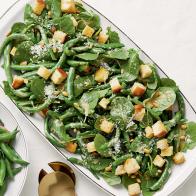The Best and Worst Canned and Jarred Foods at the Grocery Store
Use this handy list the next time you're shopping the middle aisles.
Related To:
Photo By: the_burtons
Photo By: YelenaYemchuk
Photo By: Stephen Murello
Photo By: FotografiaBasica
Photo By: Francisco Javier Herrero Isla / EyeEm
Photo By: FotografiaBasica
Photo By: FotografiaBasica
Photo By: Paula Banks
Photo By: lleerogers
Photo By: happy_lark
Your Grocery Store "Cheat Sheet"
When at the supermarket, you’ll find aisle after aisle of jarred and canned food. It can certainly get confusing to know which you should pick and which you should avoid. To make your healthy shopping easier, here’s a simple "cheat sheet" for the ones you should pick up (labeled as "the best") and ones you should avoid (labeled as "the worst").
Best: Canned Beans
One cup of canned kidney beans provides over 13 grams of both plant-based protein and fiber. Both protein and fiber help keep you satisfied longer. Fiber has many other benefits, including keeping your gastrointestinal tract healthy. Canned beans are precooked, which helps save you time in the kitchen. They’re also convenient to mash into a dip or spread, toss into a salad, or add to soups and stews. When shopping for canned beans, look for low-sodium or no-added-salt varieties. Rinsing beans under cool water can also help reduce the sodium by up to 40%.
Worst: Baked Beans
This can of ready-to-serve precooked beans is flavored with spices and loads of sugar, salt and sometimes even saturated fat (if made with bacon). It really turns a very healthy ingredient — beans — into a dish that’s anything but. Instead, make Ellie Krieger’s baked beans (pictured here).
Get the Recipe: Baked Beans with Ham
Best: Canned Tuna
Canned tuna is an affordable high-protein food that also provides a healthy dose of omega-3 fatty acids. The omega-3 fats EPA (eicosapentaenoic acid) and DHA (docosahexaenoic acid) found in tuna have been shown to help fight inflammation and provide heart health benefits. Toss tuna on top of a green salad, spread it onto a sandwich or use it to fill lettuce cups. When choosing canned tuna, opt for chunk light tuna packed in water. If you want a little canned fish variety, opt for canned salmon and sardines in water, which provide similar benefits.
Worst: Canned Fruit in Heavy Syrup
Canned fruit is absolutely healthy, and most Americans need more fruits, which can be eaten in any form — fresh, canned, frozen and dried. But when it comes to canned fruit, there’s no need to buy it in heavy syrup, which is laden with added sugar. Eating canned fruit packed in heavy syrup can easily push you over the max amount of added sugar recommended by the 2020-2025 Dietary Guidelines for Americans, which is 10% of your daily calories. Instead, choose canned fruit in its own juices, 100% juice, light or extra-light syrup, all of which count toward your recommended daily amount of fruit.
Best: Canned Vegetables
According to the 2020-2025 dietary guidelines for Americans, 90% of Americans do not meet the recommended amount of veggies. Canned vegetables are a quick, convenient and healthy way to help you get your veggies, along with the fiber, vitamins and minerals they contain. Canned vegetables can easily be thrown together as a quick side, as well as mixed into grains dishes, soups or stews. When shopping, look for low-sodium or no-added-salt varieties.
Worst: Canned Pasta
Canned pasta is certainly a nostalgic food, but it should be left in the past. Many old-school brands contain lots of added sugar, salt and artery-clogging saturated fat. Instead make your own with whole-grain pasta and a homemade tomato sauce or meat sauce made with lean ground meat or poultry. And don’t forget to add lots of veggies, like in this Pasta Primavera or this Turkey Bolognaise.
Best: Canned Tomatoes
Tomatoes are bursting with the antioxidant vitamins A and C and potassium. Processed tomatoes, like canned tomatoes, also provide the antioxidant lycopene, which has been linked with a lower risk of cardiovascular disease, prostate cancer and macular degeneration (poor eyesight that can result as you age). Canned tomatoes come in many varieties, including diced, crushed and paste. Use them for a variety of dishes, like chili, pasta or even eggs. When shopping for canned tomatoes, choose low-sodium or no-added-sodium varieties when possible.
Worst: Jarred Sauces
The jarred sauces that really can do some damage include Alfredo, vodka, cheese-based and meat sauces. These sauces are rich and decadent, and they contain loads of salt, added sugar and saturated fat. The serving size of these sauces is typically listed as one-quarter cup, but oftentimes two, three or even four times the amount is used, racking up unhealthy nutrients that can lead to chronic diseases like heart disease and obesity if eaten regularly. Instead, opt for a heart-healthier sauce, like pesto (or make your own with a splash of olive oil and fresh herbs).
Best: Canned Pumpkin
This delicious winter squash deserves to be highlighted on its own. Pumpkin holds copious amounts of the antioxidant vitamin A, helping keep your immune system healthy by fighting free radicals that can damage your body’s cells. Canned pumpkin is best known for its use in pumpkin pie, but you can also add it to pancake or cookie batters, soups, stews, tomato sauce, smoothies, or even oatmeal. When buying canned pumpkin, look for 100% pumpkin puree in the ingredients and nothing else. Skip the pumpkin pie mix filled with added sugar.
Worst: Canned Coconut Cream
Coconut cream is more concentrated compared to coconut milk and therefore has more calories. Much of the fat comes from saturated fat, which has been shown to raise LDL (or "bad") cholesterol. According to the 2020-2025 Dietary Guidelines for Americans, coconut is considered a saturated fat (as are the derivatives of coconut, like milk, oil and cream), and the guidelines recommend that no more than 10% of total calories should come from saturated fat. Two tablespoons of coconut cream provide 60 calories and 5 grams of saturated fat (that’s 25% of the recommended daily amount!). If you want a little coconut, opt for light coconut milk instead.



































